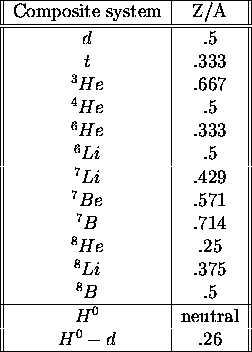The field in both spectrometer magnets will be set to +0.75T to optimize acceptance
for species with Z/A=+1/2. The primary physics emphasis in this run is to study
the central production of nuclei. This will help to understand the dynamics involved
in producing composite systems.
The species to be studied in this run are listed in Table ![]() . The positive
value of the field means that the magnet is set to deflect positive particles into the
experimental acceptance. With the multiplicity trigger only it is possible even with
modest beam rate to saturate the DA system rate of 4000 events per spill. In 100 (calendar)
hours, assuming an AGS macro duty cycle of 20%, a total of
. The positive
value of the field means that the magnet is set to deflect positive particles into the
experimental acceptance. With the multiplicity trigger only it is possible even with
modest beam rate to saturate the DA system rate of 4000 events per spill. In 100 (calendar)
hours, assuming an AGS macro duty cycle of 20%, a total of ![]() central
collisions will be recorded.
central
collisions will be recorded.

Table: Centrally produced composites studied in Run A
The acceptance times efficiency of the apparatus for the positive nuclei listed in the table
is about 4%. (See Table ![]() .) The efficiency of the calorimeter, as
discussed in the section on the calorimeter simulation, is 42%. We note that there is no live
time correction here since the 4000 events per spill is DA limited.
.) The efficiency of the calorimeter, as
discussed in the section on the calorimeter simulation, is 42%. We note that there is no live
time correction here since the 4000 events per spill is DA limited.
Thus, the species studied in this run will be detected at a sensitivity of one event per:
![]()
![]()
![]()
For the more abundant species and species with charge greater than 1 where
use of the calorimeter is probably not necessary this number will double.
We note that the typical rate for mass 8 nuclei predicted by a thermodynamic model
is around ![]() per central collision. This would give about 50 reconstructed
particles for a mass 8 nucleus in this run.
per central collision. This would give about 50 reconstructed
particles for a mass 8 nucleus in this run.
We note that we can also search for the composite charged ![]() system
in Run A. The yield
of
system
in Run A. The yield
of ![]() in 14.5 Gev/c Si ions on Au has been estimated to be
in 14.5 Gev/c Si ions on Au has been estimated to be ![]() -
- ![]() per
central collision. This would surely be higher for Au-Au collisions. We know
that deuterons are ``plentiful'' so that our sensitivity of
per
central collision. This would surely be higher for Au-Au collisions. We know
that deuterons are ``plentiful'' so that our sensitivity of
![]() per
collision would appear to be significant.
per
collision would appear to be significant.